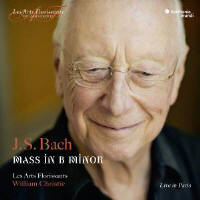Texte paru dans: / Appeared in: |
|
|
Outil de traduction ~ (Très approximatif) |
|
|
Reviewer: Huntley
Dent One expects that William Christie’s approach to the mighty B-Minor Mass will be drastically pared down from the cathedral-filling style of the early Bach Revival 60 years ago. In terms of small forces and quicker tempos he’s part of the general trend. But he sets himself apart when he says, “My goal in this recording is to show a human side of Bach’s art. Indeed, the B-Minor Mass is an affirmation of Christian faith but just as important, for a secular society of today, it is a powerful affirmation of humanism, the exaltation of man and his achievements.”
Perhaps, I thought, the combination of modesty and humanism would bring the B-Minor Mass home from its chilly exile as yet another sacrifice to HIP dogma. So it proves. Christie’s forces, both choral and instrumental, play in a tender, luminous style. Another point he makes is about the reason for smaller forces: “Fewer musicians … creates an atmosphere of chamber music, giving an independence and a freedom to both soloists and instrumentalists.” This is very evident in the performance, removing the air of “official Bach” that was present as far back as Karl Richter or as recently as the latest authenticity-minded recording. Taking Bach off the high altar doesn’t improve matters if he winds up at a musicology conference.
So far, Christie is as good as his word, but he has something else to add. “Bach himself conducted from the keyboard, sometimes beating time in the larger movements. Otherwise he played along with his fellow musicians, realizing the continuo baseline. And so do I! I am a continuo player … who thus participates in the joy of music making.” In nine of the Mass’s 26 numbers he doesn’t conduct at all. That can change the tenor of the music considerably, as in the Christe eleison, which becomes, in Christie’s words, “a light-hearted duo for two treble voices.” In other words, humanism doesn’t arrive at the same point as Bach’s Lutheranism, in which suffering, penance, and the imploring of a sinful soul were as central as ecstasy, communion, and redemption. If Christie therefore gives us a one-sided B-Minor Mass, making Bach a creature of pure light, I can’t complain; the score has evolved with the beliefs of its audiences. Niggling disagreements vanish in the face of two great virtues in this new recording: the beautiful choral singing and instrumentalists who play the orchestral parts in the spirit of chamber music. The chorus is adult, consisting of seven sopranos, three mezzos, two countertenors, four tenors, and five basses. There is no overlap with the four soloists. For ensemble, intonation, and emotional sincerity the choral singing cannot be faulted—you never feel that HIP widgets are put in place to carry out the conductor’s marching orders. I wish that the bass voices weren’t uniformly light, but that’s been the norm for a long time in Baroque choral singing. There’s enough warmth in the singing, even without vibrato, that the sopranos don’t turn the sound too “white.” In the fastest choral numbers, like Cum Sancto Spiritu, it’s thrilling to hear such accurate execution.
The orchestra consists of 29 members plus Christie on harpsichord. Transverse flûtes allemandes are used in place of recorders, and the continuo is filled out with a modest chamber organ and obbligato contrabass. The purpose of the massive Bach one heard traditionally was to cement the faith of a large community in a universal act of devotion. The purpose of modern Bach is often rather vague about Christianity. Christie veers toward the abstract. Although a man of the theater, and there are many moments of striking theatricality despite the formality of the Latin Mass—you get the sense here of an underlying narrative as powerful as in the Passions. Yet equally important is Christie’s desire to give us a display of the art of polyphony.
The four soloists play their principal part in the complex polyphonic structures being brought out, and for me that’s a limitation. I want singers who express individuality; Christie doesn’t. He wants clarity and precision. Dehumanizing his solo singers pulls against the expressed purpose of a more humane B-Minor Mass, but there you are. In the solo quartet the most beautiful voices belong to soprano Katherine Watson and countertenor Tim Mead. They blend sweetly in the Christe eleison but sound too chirpy for my taste. Tenor Reinoud Van Mechelen has a light, whiny tone that I’d happily not encounter again. Little in Bach is more taxing for a bass than the Quoniam tu solus Sanctus, and having heard a dozen dismal-to-mediocre attempts, I commend André Morsch for showing such vocal ease, the praise to be shared with the excellent hornist Anneke Scott, who makes easy work of an obbligato part wrecked in many other recordings. In the past great singers on the order of Janet Baker, Christa Ludwig, Kathleen Ferrier, Elisabeth Schwarzkopf, Peter Schreier, and Paul Schöffler have appeared in post-World War II recordings of the B-Minor Mass where their contribution was deeply moving. Exchanging soloists of that caliber for nimble, light, impersonal singers is hard. But the strength of Christie’s performance lies in the spectacle of polyphonic genius on display from a superb chorus and orchestra, everything done in a humane spirit. I could easily live with this set as my first choice.
The recorded sound is crystal clear, as befits the transparency of the music-making. The text of the Latin Mass is included with translations. The recording was made in September 2016 in the new Philharmonie de Paris. | |
|
|
|
|
|
|
|
Cliquez l'un ou l'autre
bouton pour découvrir bien d'autres critiques de CD |
|




